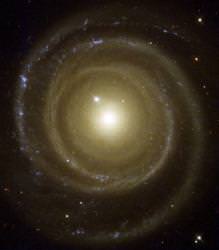As galaxies rotate, their spiral arms usually sweep back, trailing behind the rotation of the galaxy. But astronomers have found a galaxy that defies this convention, with its arms opening outward in the same direction as the rotation of the galaxy’s disk.
The galaxy, known as NGC 4622, lies 200 million light years away in the constellation Centaurus. A team of American astronomers analyzed images of the galaxy, and discovered that it has a previously hidden inner counter clockwise pair of spiral arms.
“Contrary to conventional wisdom, with both an inner counter-clockwise pair and an outer clockwise pair of spiral arms, NGC 4622 must have a pair of leading arms,” said Dr. Gene Byrd from the University of Alabama. “With two pairs of arms winding in opposite directions, one pair must lead and one pair must trail. Which way is which depends on the disk’s rotation. Alternatively, the inner counter clockwise pair must be the leading pair if the disk turns counter clockwise.”
This isn’t the first time the team announced their findings that NGC 4622 had a leading pair of spiral arms. Other astronomers were skeptical of the result, since the galaxy disk is only tilted 19 degrees from face-on, and clumpy clouds of dust could confuse the results.
The researchers came back and used two different independent techniques to verify the direction the arms are spinning.
Further observations are coming, since images from the Hubble Space Telescope revealed a dark dust lane in the centre of the galaxy. This suggests that NGC 4622 may have consumed a smaller companion galaxy, and this could help explain where the additional spiral arms came from.
Original Source: University of Alabama News Release


Two quich questions please, When do you think that galaxy NGC 4622 may have consumed another galaxy? And if it did consume another galaxy how would it have gained additional spiral arms?
So which rules of gravity and motion apply and which are being discarded in this scenario?
Say, fellow posters, take a look at this week’s articles, starting with this one and working back. If this keeps up, Fraser can shut down the ATM section, the mainstreamers are doing ATM themselves, including ideas that would have been laughed off ATM. And the mainstreamers have the observations to back up their claims. Now for some independent verification.
My favorite so far is the intermediate black holes from globular clusters.
It is a beautiful, delicate looking galaxy. A merger probably happened long ago. Knowing if there are rapid star-forming areas in the galaxy may answer how long ago a merger took place. Are there any Spitzer images of NGC 4622?
For me, I have to take the position that it is impossible for a galaxy to have two sets of arms that are connected, to be rotating in opposite directions.
If the opposing spin of one set of arms was really due to an assumed collision with another (unknown) body, as suggested by the U of Alabama team, it would be most likely that the resulting motion of the contacted arm would be very unlike the opposing arm — but in reality, the arm motion of each side are quite similar to each other (nearly symmetrical). It would be most likely that the resulting motion of one arm, if contacted by an alien body, would be, at least, somewhat ‘out-of-plane’ with respect to the rest of the parent galaxy.
My view of NGC 4622 indicates that —
o two arms initially formed each on opposite sides of the parent body.
o they continually expanded outward around the parent at slightly greater than escape velocity.
o then when they reached about 180 deg from their origin, one continues on, but the other splits into two sub-arms.
o the outer sub-arm takes on a slight increase in escape velocity and continues a pattern away from its parent.
o the inner sub-arm slows somewhat from its original speed (decreases escape velocity) and, consequently, patterns inward toward its parent.
o this altered inner sub-arm trajectory (as well as the outer sub-arm) may now be tilted somewhat out of its original plane of motion.
o this slower inner sub-arm motion could now give the impression to an observer that it is an arm that is moving in the opposite direction from which it originated — opposite motion from the outer arms. But I believe that it is simply continuing on in its original general direction, but at a slower speed, and moving inward toward its parent. Slower than escape velocity will cause it to traject into its parent somewhat like a near vertical rocket launch from earth.
What caused the arm split? Who knows? But it could be the same object presumed by the U of Alabama team to have collided with NGC 4622 to cause the reversal in arm rotation. No one could possibly determine when it impacted, where it contacted NGC 4622, its size, shape, density, velocity, direction of motion at impact with respect to the path of NGC 4622.
It appears to me that my hypothesis (impacting body splits an arm) is certainly questionable, but it appears to be more logical than an impacting body causing a reversal in arm rotation.
Readers — what are your thoughts?